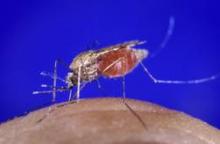The new spiroindolone antimalarial agent, KAE609, rapidly cleared both Plasmodium falciparum and P. vivax from the blood in a small, industry-funded phase II trial reported online July 31 in the New England Journal of Medicine.
The rapidity of clearance is key because slower clearance is associated with drug resistance. "To date, the most rapidly acting antimalarial agents have been the artemisinins; however, these preliminary data suggest that KAE609 may effect an even faster parasitic clearance, including in patients with artemisinin-resistant" malaria, said Dr. Nicholas J. White of Mahidol University, Bangkok, Thailand, and the Centre for Tropical Medicine, University of Oxford (England) and his associates.
This open-label exploratory trial involved 21 adults with uncomplicated P. falciparum (11 patients) or P. vivax (10 patients) malaria who were closely monitored at three inpatient facilities in Thailand during treatment. They received three oral 10-mg capsules of KAE609 per day for 3 days. Blood smears were analyzed every 4-6 hours.
The median time to parasite clearance was 12 hours in both groups of patients. The median parasite clearance half-life was 0.95 hours for P. vivax and 0.90 hours for P. falciparum. "By comparison, only 19 of 5,076 patients (less than 1%) with falciparum malaria in [a study in] Southeast Asia who had been treated with oral artesunate and evaluated similarly had a parasite clearance half-life of less than 1 hour," the investigators said (N. Engl. J. Med. 2014 July 31 [doi: 10.1056/NEJMoa1315860]).
Four of five patients who carried kelch protein mutations thought to be associated with resistance to artemisinins showed the same rapid parasite clearance as noncarriers, and the fifth dropped out of the study. Thus, KAE609 (formerly known as NITD6049, Novartis Institute for Tropical Diseases) appears to be effective even against artemisinin-resistant malaria. The drug also showed gametocytocidal activity in in vitro studies, so it may have transmission-blocking properties as well, Dr. White and his associates said.
Nausea, vomiting, and elevated liver enzymes were the most common adverse effects that occurred during treatment, but all of these are characteristic of the underlying infection and may not have been drug related. "Much larger studies will be necessary to assess fully the safety and adverse-event profile of this new antimalarial agent," they added.
This study was funded by Novartis; the Mahidol-Oxford Tropical Medicine Research Unit is supported by the Wellcome Trust of Great Britain. Dr. White and his associates reported no other ties to industry sources.


